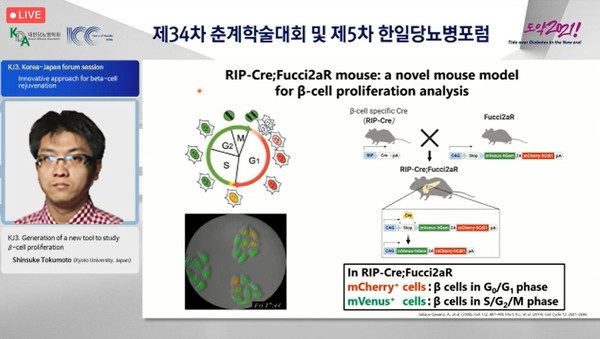Metabolic
Korean and Japanese experts share approaches to regenerate pancreatic B cells in diabetics

Researchers from Korea and Japan shared the results of innovative approaches to pancreatic beta cell regeneration in diabetics at the Korean Diabetes Association’s 34th Spring Conference on Saturday.
Two experts from each country – Professors Kim Hyeong-seok from Chungnam National University College of Medicine, Lee Myung-shik from Yonsei University College of Medicine, Shinsuke Tokumoto from Kyoto University, and Masayuki Shimoda from Japan’s National Center for Global Health and Medicine – – presented possible therapeutic options related to pancreatic problems for diabetic patients.
Professor Kim explained how lactation improves the mass and function of the beta cells in the pancreas through the production of serotonin. His study results suggest that serotonin mediates the long-term beneficial effects of lactation on metabolic health in women with increased beta cell proliferation and decreased oxidative stress.
Professor Kim’s research team confirmed the long-term beneficial effects of lactation on beta cell function, which lasts for years.
Kim noted that pregnancy places significant metabolic stress on women with weight gain and insulin resistance. During lactation, the prolactin-induced serotonin production in beta cells and the serotonin stimulated the proliferation of the beta cells. In addition, intracellular serotonin acted as an antioxidant to reduce oxidative stress and improve beta cell survival.
Professor Lee Myung-shik of Yonsei University College of Medicine speaks at a global conference of the Korean Diabetes Association on Saturday about how autophagy can improve the survival and function of beta cells in diabetic patients.
Professor Lee said autophagy enhancers could potentially help patients fight diabetes, which is characterized by islet amyloid buildup.
According to Lee, a recently identified autophagy enhancer (MSL-7) reduced the accumulation of monkey IAPP (sIAPP) and hIAPP oligomers, improved the glucose profile and fatty liver of obese mice with increased lipolysis, while lowering metabolic inflammation.
Lee said he found that 90 percent of diabetics had islet amyloid deposition due to differences in the amino acid sequences of the islet amyloid polypeptide (IAPP). Islet, part of the pancreas, contains several types of cells, including beta cells, that produce insulin to help break down food and regulate glucose.
“We have reported that autophagy plays a key role in the elimination of the amyloidogenic human IAPP (hIAPP) oligomer,” said Lee. “We found potential management through the use of an autophagy enhancer that could act as a therapeutic method for diabetes characterized by islet amyloid accumulation.”
Professor Tokumoto introduced a new animal model for assessing beta cell proliferation that could alleviate the progression of diabetes.

At the same conference, Professor Shinsuke Tokumoto from Kyoto University is introducing a new animal model that will be used to assess beta cell proliferation, which could alleviate the progression of diabetes.
Tokumoto stated that various factors may affect beta cell replication. However, current knowledge is limited due to the non-standardized assay and the lack of alternative methods. In his study, the researchers tried to develop a novel mouse model with the help of which a more precise quantification of the proliferation of beta cells can be found using a biosensor for monitoring the cell cycle (Fucci2a).
“We found a strong association between islet size and the amount of beta cells, suggesting that the novel mouse model could be used as a new tool for assessing beta cell proliferation,” said Tokumoto.
Professor Shimoda said Japan recently confirmed positive results from the Phase 3 clinical trials of the Clinical Islet Transplantation Study (CIT) -07 protocol. The primary endpoint of the study was to prevent severe hypoglycemia while keeping HbA1c below 7 percent.
Shimoda stated that an islet transplant could be a promising treatment for reducing hypoglycemia and providing excellent blood sugar control.
“The Edmonton Protocol reported by the University of Alberta in 2000 showed that the islet transplant was a promising treatment for type 1 diabetes,” he said, adding that Japan has approved and granted public health insurance for the transplant . The method became standard therapy in 2020.
However, he noted that the lack of donors is limiting the availability of an islet transplant to more patients in need of surgery. To solve this problem, researchers in Japan have explored many ways to secure cell sources.
“Once the problem of donor shortages can be resolved, islet transplantation for insulin independence in type 2 diabetes patients with reduced insulin secretion, which is more common in Asians, may be considered the next target,” said Shimoda. “The next generation of islet transplant therapies are expected to evolve with further studies.”





